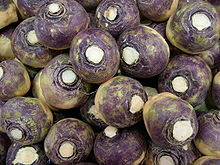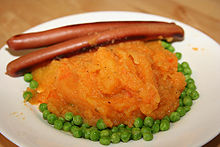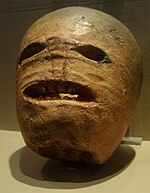Rutabaga: Difference between revisions
→History: remove tags; not just a cookbook. And the reference for the first sentence is provided at the end of the paragraph. Not every sentence needs to be cited if an entire paragraph is sourced |
|||
| Line 41: | Line 41: | ||
In Sweden and Norway, rutabaga is cooked with [[potato]] and sometimes [[carrot]], and mashed with [[butter]] and either stock or, occasionally, [[milk]] or [[cream]], to create a puree called ''rotmos'' (Swedish, literally: root mash) or ''kålrabistappe'' (Norwegian). [[Onion]] is occasionally added. In Norway, ''kålrabistappe'' is an obligatory accompaniment to many festive dishes, including ''[[smalahove]]'', ''[[pinnekjøtt]]'', ''[[raspeball]]'' and salted [[herring]]. In Sweden, ''rotmos'' is often eaten together with cured and boiled [[ham hock]], accompanied by [[Mustard (condiment)|mustard]]. This classic Swedish dish is called ''[[fläsklägg med rotmos]]''. In Wales, a similar mash produced using just potato and rutabaga is known as ''ponch maip''. |
In Sweden and Norway, rutabaga is cooked with [[potato]] and sometimes [[carrot]], and mashed with [[butter]] and either stock or, occasionally, [[milk]] or [[cream]], to create a puree called ''rotmos'' (Swedish, literally: root mash) or ''kålrabistappe'' (Norwegian). [[Onion]] is occasionally added. In Norway, ''kålrabistappe'' is an obligatory accompaniment to many festive dishes, including ''[[smalahove]]'', ''[[pinnekjøtt]]'', ''[[raspeball]]'' and salted [[herring]]. In Sweden, ''rotmos'' is often eaten together with cured and boiled [[ham hock]], accompanied by [[Mustard (condiment)|mustard]]. This classic Swedish dish is called ''[[fläsklägg med rotmos]]''. In Wales, a similar mash produced using just potato and rutabaga is known as ''ponch maip''. |
||
[[File:A haggis serving.JPG|thumb|Haggis served with tatties and neeps]] |
[[File:A haggis serving.JPG|thumb|Haggis served with tatties and neeps]] |
||
In Scotland, rutabaga and potato are boiled and mashed separately to produce " |
In Scotland, rutabaga and potato are boiled and mashed separately to produce "tatties and neeps" ("tatties" being the [[Scots language|Scots]] word for potatoes), traditionally served with the Scottish national dish of [[haggis]] as the main course of a [[Burns supper]]. Neeps may also be mashed with potatoes to make [[clapshot]]. Regional variations include the addition of onion to clapshot in [[Orkney]]. Neeps are also extensively used in soups and stews. |
||
In England, swede is regularly eaten mashed as part of the traditional [[Sunday roast]]. Often it is boiled together with carrots and served either mashed or pureed with butter and ground pepper. The flavored cooking water is often retained for soup, or as an addition to gravy. Rutabaga is an essential vegetable component of the traditional Welsh lamb broth called [[cawl]]. Rutabaga is also a component of the popular condiment [[Branston Pickle]]. |
In England, swede is regularly eaten mashed as part of the traditional [[Sunday roast]]. Often it is boiled together with carrots and served either mashed or pureed with butter and ground pepper. The flavored cooking water is often retained for soup, or as an addition to gravy. Rutabaga is an essential vegetable component of the traditional Welsh lamb broth called [[cawl]]. Rutabaga is also a component of the popular condiment [[Branston Pickle]]. |
||
Revision as of 17:20, 14 November 2013
| Rutabaga | |
|---|---|

| |
| Scientific classification | |
| Kingdom: | |
| (unranked): | |
| (unranked): | |
| (unranked): | |
| Order: | |
| Family: | |
| Genus: | |
| Species: | B. napobrassica
|
| Binomial name | |
| Brassica napobrassica | |
The rutabaga, swede (from Swedish turnip),[1] turnip, yellow turnip, or neep (Brassica napobrassica, or Brassica napus var. napobrassica, or Brassica napus subsp. rapifera) is a root vegetable that originated as a cross between the cabbage and the turnip; see Triangle of U. The roots are prepared for human food in a variety of ways, and the leaves can be eaten as a leaf vegetable. The roots and tops are also as winter feed for livestock, when they may be fed directly, or by allowing the animals to forage the plants in the field.
Etymology


Brassica napobrassica has many national and regional names. Rutabaga is the common American and Canadian term for the plant. This comes from the old Swedish word Rotabagge, meaning simply "ram root". In the U.S., the plant is also known as Swedish turnip or yellow turnip. The term swede is used instead of rutabaga in many Commonwealth Nations, including much of England, Wales, Australia, and New Zealand. The name turnip is also used in parts of Northern and Midland England, the Westcountry (particularly Cornwall), Ireland, Manitoba, Ontario and Atlantic Canada. In Scotland, it is known as turnip, and in Scots as tumshie or neep (from Old English næp, Latin napus).[2] Some areas of south east Scotland, such as Berwickshire and Roxburghshire, still use the term baigie, possibly a derivative of the original Swedish rutabaga.[3] The term "turnip" is also used for the white turnip (Brassica rapa ssp rapa).[2][4] Some[who?] will also refer to both swede and (white) turnip as just "turnip" (this word is also derived from næp).[4] In North-East England, turnips and swedes are colloquially called snadgers, snaggers (archaic) or narkies.[citation needed]
Its common name in Sweden is kålrot (literally "cabbage/kale root"). Similarly, in Denmark it is known as kålroe and kålrabi, while in Norway it known as kålrabi in addition to being known as kålrot. In Denmark and Norway kålrabi is sometimes confused with Swedish kålrabbi (which corresponds with German Kohlrabi). The Finnish term is lanttu. Rutabaga is known as Steckrübe in German.
History

The first known printed reference to the rutabaga comes from the Swiss botanist Gaspard Bauhin in 1620, where he notes that it was growing wild in Sweden. It is often considered to have originated in Scandinavia or Russia.[5] It is said to have been widely introduced to Britain around 1900, but it was recorded as being present in the royal gardens in England as early as 1669 and was described in France in 1700. It was asserted by Sir John Sinclair in his Husbandry of Scotland to have been introduced to Scotland around 1781–1782. An article on the topic in The Gardeners' Chronicle suggests that the rutabaga was then introduced more widely to England in 1790. Introduction to North America came in the early 19th century with reports of rutabaga crops in Illinois as early as 1817.[6]
Botanical history
Rutabaga has a complex taxonomic history. The earliest account comes from the Swiss botanist Gaspard Bauhin, who wrote about it in his 1620 Prodromus.[6] Brassica napobrassica was first validly published by Carl Linnaeus in his 1753 work Species Plantarum as a variety of B. oleracea: B. oleracea var. napobrassica.[7] It has since been moved to other taxa as a variety, subspecies, or elevated to species rank. In 1768, a Scottish botanist elevated Linnaeus' variety to species rank as Brassica napobrassica in The Gardeners Dictionary, which is the currently accepted name.[8]
Rutabaga has a chromosome number of 2n = 38. It originated from a cross between turnip (Brassica rapa) and Brassica oleracea. The resulting cross then doubled its chromosomes, becoming an allopolyploid. This relationship was first published by Woo Jang-choon in 1935 and is known as the Triangle of U.[9]
Human food

Finns cook rutabaga in a variety of ways: roasted (to be served with meat dishes), baked, boiled, as a flavor enhancer in soups, uncooked and thinly julienned as a side dish or in a salad, and as the major ingredient in the popular Christmas dish Swede casserole (lanttulaatikko). Finns use rutabaga in most dishes that call for any root vegetable.

In Sweden and Norway, rutabaga is cooked with potato and sometimes carrot, and mashed with butter and either stock or, occasionally, milk or cream, to create a puree called rotmos (Swedish, literally: root mash) or kålrabistappe (Norwegian). Onion is occasionally added. In Norway, kålrabistappe is an obligatory accompaniment to many festive dishes, including smalahove, pinnekjøtt, raspeball and salted herring. In Sweden, rotmos is often eaten together with cured and boiled ham hock, accompanied by mustard. This classic Swedish dish is called fläsklägg med rotmos. In Wales, a similar mash produced using just potato and rutabaga is known as ponch maip.

In Scotland, rutabaga and potato are boiled and mashed separately to produce "tatties and neeps" ("tatties" being the Scots word for potatoes), traditionally served with the Scottish national dish of haggis as the main course of a Burns supper. Neeps may also be mashed with potatoes to make clapshot. Regional variations include the addition of onion to clapshot in Orkney. Neeps are also extensively used in soups and stews.
In England, swede is regularly eaten mashed as part of the traditional Sunday roast. Often it is boiled together with carrots and served either mashed or pureed with butter and ground pepper. The flavored cooking water is often retained for soup, or as an addition to gravy. Rutabaga is an essential vegetable component of the traditional Welsh lamb broth called cawl. Rutabaga is also a component of the popular condiment Branston Pickle.
In Canada, rutabaga is used as filler in foods such as mincemeat and Christmas cake, or in Atlantic Canada as a side dish with Sunday dinner. In Canada, they are often referred to as "turnips".
In the US, rutabaga is mostly eaten as part of stews or casseroles, served mashed with carrots, or baked in a pasty. They are frequently found in the New England boiled dinner.
In Australia, rutabaga is used in casseroles, stews and soups as a flavor enhancer.
Despite their popularity elsewhere, rutabaga is considered a food of last resort in Germany due to its association with food shortages in World War I and World War II. Boiled stew with rutabaga and water as the only ingredients (Steckrübeneintopf) was a typical food in Germany during the famines and food shortages of World War II and the following years. As a result, many older Germans have unhappy memories of this food. Although the rutabaga is still eaten in parts of Northern Germany, most Germans prefer to use kohlrabi (German turnip) instead.
Phytochemistry
| Nutritional value per 100 g (3.5 oz) | |||||||||||||||||||||||||||||||||||||||||
|---|---|---|---|---|---|---|---|---|---|---|---|---|---|---|---|---|---|---|---|---|---|---|---|---|---|---|---|---|---|---|---|---|---|---|---|---|---|---|---|---|---|
| Energy | 157 kJ (38 kcal) | ||||||||||||||||||||||||||||||||||||||||
8.62 g | |||||||||||||||||||||||||||||||||||||||||
| Sugars | 4.46 g | ||||||||||||||||||||||||||||||||||||||||
| Dietary fiber | 2.3 g | ||||||||||||||||||||||||||||||||||||||||
0.16 g | |||||||||||||||||||||||||||||||||||||||||
1.08 g | |||||||||||||||||||||||||||||||||||||||||
| |||||||||||||||||||||||||||||||||||||||||
| †Percentages estimated using US recommendations for adults,[10] except for potassium, which is estimated based on expert recommendation from the National Academies.[11] | |||||||||||||||||||||||||||||||||||||||||
Rutabaga and other cyanoglucoside-containing foods (including cassava, maize (corn), bamboo shoots, sweet potatoes, and lima beans) release cyanide, which is subsequently detoxified into thiocyanate. Thiocyanate inhibits thyroid iodide transport and, at high doses, competes with iodide in the organification process within thyroid tissue. Goitres may develop when there is a dietary imbalance of thiocyanate-containing food in excess of iodine consumption, and it is possible for these compounds to contribute to hypothyroidism.[12][13][14][15] Yet, there have been no reports of ill effects in humans from the consumption of glucosinolates from normal amounts of Brassica vegetables. Glucosinolate content in Brassica vegetables is estimated to be around one percent of dry matter. These compounds are also responsible for the bitter taste of rutabaga.[16]
As with watercress, mustard greens, turnip, broccoli and horseradish, human perception of bitterness in rutabaga is governed by a gene affecting the TAS2R bitter receptor, which detects the glucosinolates in rutabaga. Sensitive individuals with the genotype PAV/PAV find rutabaga twice as bitter as insensitive subjects (AVI/AVI). For the mixed type (PAV/AVI), the difference is not significant for rutabaga.[17] As a result, sensitive individuals may find rutabaga so bitter as to be inedible.
Other chemical compounds that contribute to flavor and odor include glucocheirolin, glucobrassicanapin, glucoberteroin, gluconapoleiferin, and glucoerysolin.[18] Several phytoalexins that aid in defense against plant pathogens have also been isolated from rutabaga, including three novel phytoalexins that were reported in 2004.[19]
Rutabaga contains significant amounts of vitamin C: 100 g contains 25 mg, which is 42% of the daily recommended dose.[20]
Other uses
Livestock
This section needs expansion. You can help by adding to it. (November 2013) |
The roots and tops are used as winter feed for livestock. They may be fed directly (chopped or from a hopper), or animals may be allowed to forage the plants directly in the field.[21]
Halloween

People living in Ireland and Scotland have long carved turnips and used them as lanterns to ward off harmful spirits.[22] In the Middle Ages, rowdy bands of children roamed the streets in hideous masks carrying carved turnips known in Scotland as "tumshie heads".[23][24] In modern times, turnips are often carved to look as sinister and threatening as possible, and are put in the window or on the doorstep of a house at Halloween to ward off evil spirits.[25][26] Since pumpkins became readily available from Europe in the 1980s, they have taken over this role for the most part.[27]
Festivals
The International Rutabaga Curling Championship takes place annually at the Ithaca Farmers' Market on the last day of the market season.[28]
See also
References
- ^ "swede". Oxford English Dictionary (Online ed.). Oxford University Press. (Subscription or participating institution membership required.)
- ^ a b The Concise Scots Dictionary, Mairi Robinson (editor) (1985)
- ^ "| Dictionary of the Scots Language", baggie, Retrieved on 25 January 2013.
- ^ a b Chambers English Dictionary (Chambers 1988), ISBN 1-85296-000-0
- ^ Hawkes, Alex D. 1968. A World of Vegetable Cookery. New York: Simon and Schuster.
- ^ a b Sturtevant, E. L. 1919. Sturtevant's Notes on Edible Plants. Albany, NY: J. B. Lyon Company, p. 105.
- ^ "Brassica napus rapifera". International Plant Names Index (IPNI). Royal Botanic Gardens, Kew; Harvard University Herbaria & Libraries; Australian National Botanic Gardens. Retrieved 30 October 2009.
- ^ International Plant Names Index (IPNI). Royal Botanic Gardens, Kew; Harvard University Herbaria & Libraries; Australian National Botanic Gardens https://www.ipni.org/n/72249-3. Retrieved 30 October 2009.
{{cite web}}: Missing or empty|title=(help) - ^ Dixon, G.R. 2007. Vegetable Brassicas and Related Crucifers. CABI: Oxfordshire, UK. pp. 6–36.
- ^ United States Food and Drug Administration (2024). "Daily Value on the Nutrition and Supplement Facts Labels". FDA. Archived from the original on 27 March 2024. Retrieved 28 March 2024.
- ^ National Academies of Sciences, Engineering, and Medicine; Health and Medicine Division; Food and Nutrition Board; Committee to Review the Dietary Reference Intakes for Sodium and Potassium (2019). Oria, Maria; Harrison, Meghan; Stallings, Virginia A. (eds.). Dietary Reference Intakes for Sodium and Potassium. The National Academies Collection: Reports funded by National Institutes of Health. Washington, DC: National Academies Press (US). ISBN 978-0-309-48834-1. PMID 30844154. Archived from the original on 9 May 2024. Retrieved 21 June 2024.
- ^ Olsson, K.; Jeppsson, L. (1984). "Undesirable glucosinolates in Brassica vegetables". Acta Hort. 163: 83–84.
- ^ Jones, D.A. (1998). "Why are so many food plants cyanogenic?". Phytochemistry. 47: 155–162.
- ^ Delange F, Iteke FB, Ermans AM. Nutritional factors involved in the goitrogenic action of cassava. Ottawa: International Development Research Centre, 1982.
- ^ Braverman LE, Utiger RD. Werner and Ingbar's The Thyroid: A Fundamental and Clinical Text, 6th Edition 1991. J.B. Lippincott Company, Philadelphia, Pennsylvania, pp. 371–2.
- ^ Verkerk, R., Schreiner, M., Krumbein, A., Ciska, E., Holst, B., Rowland, I., De Schrijver, R., Hansen, M., Gerhäuser, C., Mithen, R., and Dekker, M. 2009. "Glucosinolates in Brassica vegetables: The influence of the food supply chain on intake, bioavailability and human health." Mol. Nutr. Food Res. 53: S219-S265
- ^ Sandell, Mari A.; Breslin, Paul A.S. "Variability in a taste-receptor gene determines whether we taste toxins in food". Current Biology. 16 (18): R792. doi:10.1016/j.cub.2006.08.049.
- ^ Harborne, J. B., Baxter, H., and Moss, J. P. 1999. Phytochemical dictionary: a handbook of bioactive compounds from plants. Philadelphia, PA: Taylor and Francis, Inc.
- ^ Pedras, M. S. C.; Montaut, S.; Suchy, M. (2004). "Phytoalexins from the crucifer rutabaga: structures, syntheses, biosyntheses, and antifungal activity". J. Org. Chem. 69: 4471–4476.
- ^ "Rutabagas". Healthaliciousness.com. Retrieved 15 September 2012.
- ^ SRUC Crop Advice Directory: Swedes and Turnips
- ^ Arnold, Bettina (31 October 2001). "Bettina Arnold – Halloween Lecture: Halloween Customs in the Celtic World". Halloween Inaugural Celebration. University of Wisconsin–Milwaukee: Center for Celtic Studies. Retrieved 16 October 2007.
- ^ Rogers, Nicholas (2002). "Festive Rights: Halloween in the British Isles". Halloween: From Pagan Ritual to Party Night. pp. 43, 48. Oxford University Press.
- ^ Bannatyne, Lesley Pratt (1998). Forerunners to Halloween. Pelican Publishing Company. ISBN 1-56554-346-7 p.44
- ^ "Pumpkins Passions", BBC, 31 October 2005. Retrieved on 19 October 2006. "Turnip battles with pumpkin for Hallowe'en", BBC News, 28 October 2005. Retrieved 23 September 2007.
- ^ Published on Wednesday 28 October 2009 09:07 (28 October 2009). "Get traditional with a turnip this year - Top stories - Scotsman.com". Edinburghnews.scotsman.com. Retrieved 15 September 2012.
{{cite web}}: CS1 maint: numeric names: authors list (link) - ^ Baxter, I. A., Schröder, M. J. A., and Bower, J. A. (1999), "The influence of socio-economic background on perceptions of vegetables among Scottish primary school children", Food Quality and Preference, 10: 261–272, doi:10.1016/S0950-3293(98)00042-1
{{citation}}: CS1 maint: multiple names: authors list (link) - ^ "The International Rutabaga Curl - Ithaca Farmers Market - Ithaca NY". Rutabagacurl.com. 17 December 2011. Retrieved 15 September 2012.
External links
- Alternative Field Crops Manual: Rutabaga—Center for New Crops & Plant Products, Purdue University
- "Swede", formulaforlife.com, accessed 28 March 2012
- Smillie, Susan. "Are 'neeps' swedes or turnips?", The Guardian, 25 January 2010.
